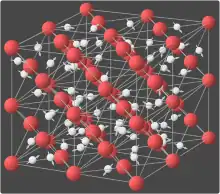Lattice scattering
Lattice scattering is the scattering of ions by interaction with atoms in a lattice.[1] This effect can be qualitatively understood as phonons colliding with charge carriers.

In the current quantum mechanical picture of conductivity the ease with which electrons traverse a crystal lattice is dependent on the near perfectly regular spacing of ions in that lattice. Only when a lattice contains perfectly regular spacing can the ion-lattice interaction (scattering) lead to almost transparent behavior of the lattice.[2]
In the quantum understanding, an electron is viewed as a wave traveling through a medium. When the wavelength of the electrons is larger than the crystal spacing, the electrons will propagate freely throughout the metal without collision.
References
External links
- Lundstrom, Mark (26 October 2000). Fundamentals of carrier transport. Cambridge University Press 2000. ISBN 0-521-63134-3.